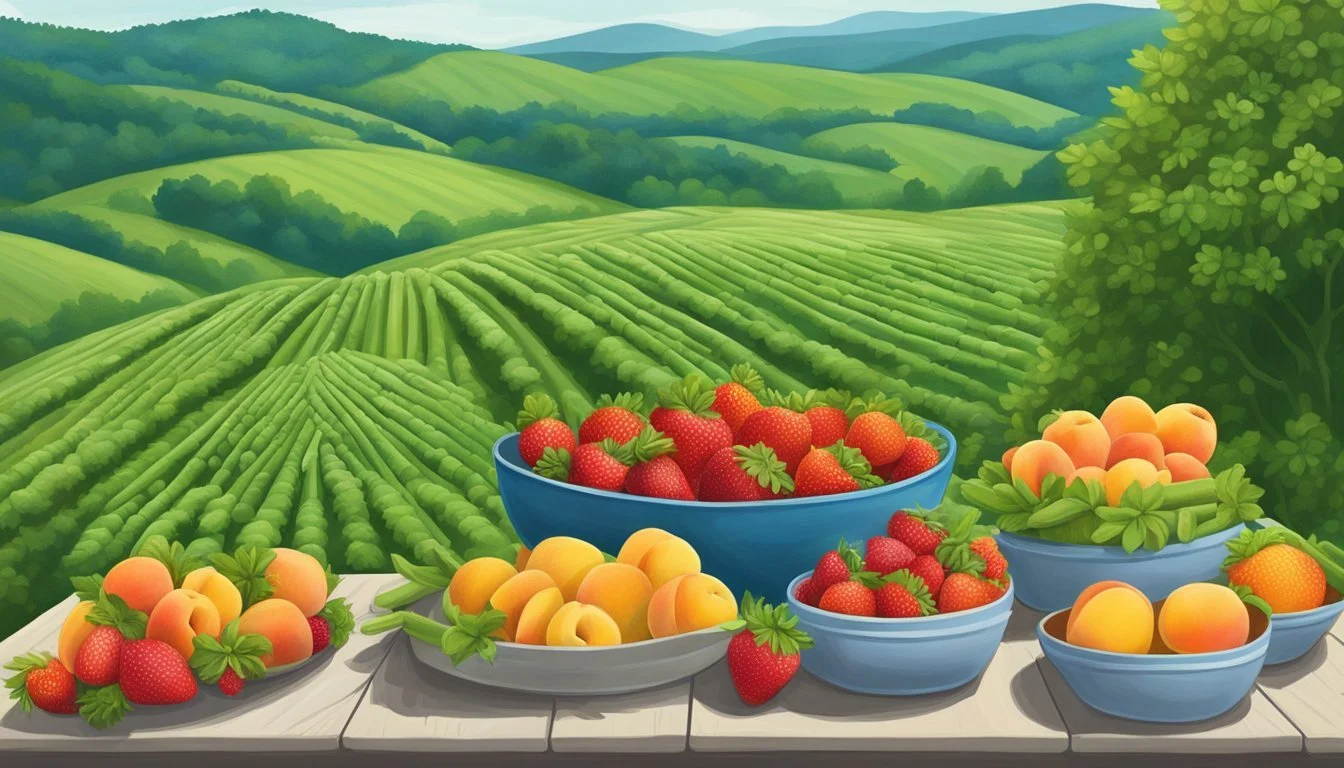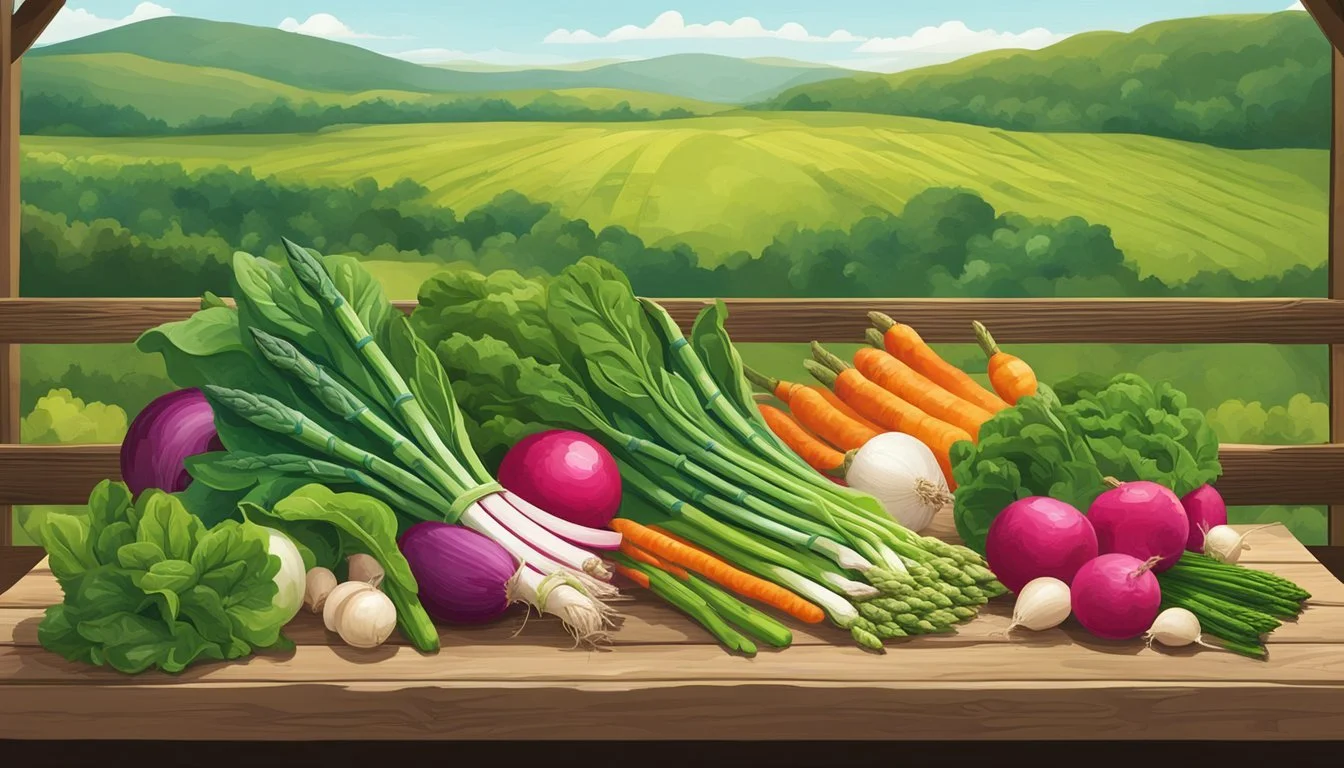West Virginia Seasonal Fruit & Vegetables in April
Your Fresh Guide
This Article is Part of our West Virginia Seasonal Fruit & Veg Calendar
West Virginia's agricultural landscape comes to life in April as the state's farms and gardens begin to produce an array of seasonal fruits and vegetables. This period marks a transitional time in the Mountain State when the last frosts of winter retreat and the longer, warmer days of spring encourage new growth. Local markets start to showcase the fresh flavors of spring, offering consumers a taste of the region's bounty.
Seasonal produce available in April includes a variety of vegetables that can withstand the still-cool nights. Hardy greens such as kale and spinach, alongside root vegetables like radishes and turnips, are found in abundance. April also signals the beginning of asparagus (how long does asparagus last?) season in West Virginia, giving patrons the opportunity to savor one of spring's first and most anticipated crops.
Fruit selections, while more limited in early spring, are nonetheless delightful. Rhubarb often makes its debut in April, straddling the line between fruit and vegetable, and is commonly used in sweet concoctions like pies and jams. These seasonal offerings not only embody the essence of West Virginia's springtime but also support local agriculture and provide fresh, nutritious options for consumers.
Understanding Seasonality in West Virginia
In West Virginia, seasonal produce cycles are closely tied to the state's climate, varying from the crisp days of spring to the cool evenings of fall. This section explores how the state's unique climate impacts what is available during different seasons, particularly in April.
Spring Season Overview
As spring emerges in West Virginia, it heralds the start of a fresh produce cycle. Already by April, the state sees a resurgence of certain vegetables and the last frost dates signal the time to begin sowing a variety of seeds. Arugula (how long does arugula last?) and asparagus are examples of spring produce that start to become available after winter's retreat. Gardeners and growers take advantage of April's milder temperatures to plant an array of crops that will mature in late spring and into the summer.
Here is a brief list of some produce that starts to become available in April:
Vegetables: Arugula, Asparagus
Fruits: Limited fruit availability; the berry season, including strawberries and raspberries, typically begins in June
Regional Climate Impacts
West Virginia's climate is characterized by moderate temperatures and distinct seasons. April is significant as it often marks the end of the frost period, with a frost-free date around April 20th to 30th depending on the region within the state. This narrowing frost window impacts the growing season which can extend up to 180 days in certain zones. The regional climate not only influences when farmers can plant but also what they can grow. Spring’s unpredictable weather, with its occasional cold snaps, can affect early plantings. Therefore, hardier vegetables are typically favored during this period of transition.
The regional climate’s impact on produce available in April includes:
Beginning of planting season post the last frost
Preparation for summer crops like watermelons to be harvested later, in August and September
Cultivation of cool-weather vegetables that can tolerate April's variable conditions
Seasonal Fruits Available in April
April brings a refreshing variety of fruits to West Virginia, with tree fruits and berries beginning to peak. This is a prime time for produce enthusiasts to explore the fresh, local offerings.
Tree Fruits and Berries
In April, while the diversity of tree fruits is more limited, some early varieties of apples may become available toward the end of the month. However, it is predominantly the time for berries to shine:
Strawberries: These begin to ripen, offering their first harvest in late April.
Raspberries: Depending on the local climate and variety, there could be some early raspberry offerings.
It's important to note that the exact timing of fruit ripeness can vary from year to year due to weather conditions.
Fresh Melons Selection
April is generally early for melons in West Virginia, which typically arrive in the warmer months. Consumers may look forward to melons like cantaloupes (how long does cantaloupe last?) and watermelons in the upcoming seasons, as they become ripe and ready for enjoyment in the summer months.
Seasonal Vegetables Available in April
April brings a diverse selection of vegetables into season in West Virginia. With the arrival of spring, the ground thaws, allowing for a variety of vegetables to thrive.
Leafy Greens and Herbs
In the rejuvenating month of April, leafy greens make a prominent resurgence in the West Virginia area. Among them, kale and lettuce are common greens that gardeners and farmers begin to harvest. The optimal growing conditions for these greens result in a fresh, vibrant flavor that is a hallmark of spring produce.
Kale: Hardy with a slightly peppery taste.
Lettuce: Ranges from crunchy icebergs to delicate butter leaf.
Root Vegetables and Tubers
Root vegetables and tubers are staples that continue to grow into April. Carrots and beets, recognized for their earthy sweetness, are typically ready for harvest. These root vegetables are rich in nutrients and flavors, amplified by the cooler spring temperatures that concentrate their sugars. Simultaneously, gardeners may also harvest turnips and potatoes, which are versatile for a variety of culinary uses.
Carrots: Sweet, crisp, and perfect for raw or cooked dishes.
Beets: Deeply pigmented, with a sweet and earthy flavor.
Potatoes: A multitude of varieties, each with distinct textures and tastes.
Turnips: Can have a sharp or sweet taste depending on age and variety.
Cruciferous and Marrow Vegetables
April sees the rise of cruciferous and marrow vegetables such as broccoli and cauliflower (how long does cauliflower last?). Their ability to withstand cooler climates makes them an ideal choice for early spring cultivation. The presence of cabbage also becomes notable in local gardens and markets. These vegetables are known for their health benefits and are a great addition to any springtime menu.
Broccoli: Offers a slightly bitter and earthy flavor, ideal for steaming or stir-frying.
Cauliflower: Mild and nutty, taking on other flavors well in cooking.
Cabbage: Can range from sweet to peppery and is excellent for salads or fermenting.
The vegetable patch in April in West Virginia is robust with a variety of textures and flavors across the range of leafy greens, root vegetables, and hearty cruciferous options, which allows for creative and healthful culinary exploration.
Gardening Tips for April
April is a pivotal month for gardeners in West Virginia, offering a window for planting cool-season vegetables and preparing for the warmer months ahead.
Planting and Maintenance
Soil Preparation: Gardeners should ensure soil is well-aerated and rich in organic matter. Testing soil for pH balance and nutrient levels, especially nitrogen, phosphorous, and potassium, is advisable. Amendments might be necessary to optimize growing conditions.
Planting: Frosts can extend into April, so it's important to plant frost-tolerant seeds directly into the soil, such as lettuce and greens. Transplants should be hardened off before planting outdoors. Consider the frost-free date of April 20 as a guide for safe planting times.
Seeds to Plant in April:
Lettuce
Spinach
Peas
Transplants that Can Be Planted:
Broccoli
Cabbage
Cauliflower
Watering: Seedlings require consistent moisture. Water early in the day to allow foliage to dry and prevent fungal diseases.
Sunlight: Full sun is critical during the day for optimal growth, but some plants, like lettuce, can benefit from partial shade to avoid early bolting.
Pest and Disease Management
Pests: Early identification and intervention are key. Handpicking pests like aphids and using barriers or organic insecticides can be effective.
Diseases: Diseases thrive in damp conditions. Ensure good air circulation around plants to reduce risk. Rotating crops annually helps prevent disease carryover in the soil.
Preventative Measures: Regularly inspect plants for signs of trouble. Remove and destroy infected plants if diseases appear to prevent spreading.
Gardeners in West Virginia can make the most of April's gardening opportunities by paying close attention to their plants' needs regarding soil quality, water, and sunlight, while staying vigilant against pests and diseases.
Local Food Markets in April
In April, West Virginia's local food markets come alive with an abundance of fresh produce. Shoppers can find the season's best offerings, with harvest times aligning to provide a variety of fruits and vegetables.
Farmers' Market Guide
Farmers' markets across West Virginia serve as bustling hubs for the freshest local produce during April. Market availability varies, but visitors can typically expect to find:
Fruits: Apples (late varieties), strawberries (beginning)
Vegetables: Greens (kale, lettuce, spinach), radishes, and spring onions
Herbs: Parsley, cilantro, and chives
Here's a snapshot of what these markets might feature in April:
Farmers' Market Location Expected Produce Charleston Strawberries, Greens, Spring Onions Morgantown Radishes, Parsley, Cilantro Huntington Apples, Chives, Lettuce
Shoppers should inquire with local vendors for exact crop availability as weather fluctuations can affect harvest times.
Community Supported Agriculture
Community Supported Agriculture (CSA) programs gain momentum in April. Members of these communities receive shares of local produce, reaping the benefits of the harvest as it becomes available. CSAs typically offer a wide selection of vegetables, such as:
Leafy Greens: Kale and spinach, known for their early harvest times.
Root Vegetables: Radishes, a spring favorite, signaling the start of the growing season.
Subscribing to a CSA in West Virginia provides insight into the seasonal rhythms and supports the local farming community directly.
Seasonal Eating Benefits
Eating seasonally, especially in West Virginia during April, offers numerous benefits. Seasonal fruits and vegetables are often at their peak in flavor and nutrition. They provide a higher content of vitamins and minerals because they are harvested at the optimal time for freshness and taste.
Local Produce: Local produce is typically fresher as it spends less time in transit from farm to table. The shorter transportation distances not only maintain the produce's nutritional integrity but also reduce water and fossil fuel consumption, contributing to a lower carbon footprint.
Nutritional Benefits: Seasonally fresh produce tends to retain more nutrients. For example, fruits and vegetables that are allowed to ripen naturally are richer in antioxidants and vitamins. There is also the added advantage of variety, allowing consumers to benefit from a wide range of nutrients over the course of the year.
Water: Seasonal produce, particularly in local contexts, often requires less supplemental watering. Nature provides what is necessary for the plant's growth cycle, promoting sustainable water use.
Consuming seasonal and local produce supports regional farmers and economies, and often results in savings for the consumer due to decreased transportation costs. Furthermore, it encourages a connection with local food systems and an understanding of where one's food originates, fostering community involvement and awareness.
Resources and Further Reading
Those interested in the specifics of West Virginia's seasonal produce offerings and agricultural patterns can consult a variety of resources. The West Virginia Produce Calendar is a valuable tool, presenting visual guidance on the availability of fruits and vegetables throughout the year.
For a narrowed focus on April's bounties, "What's In Season? West Virginia Produce Calendar" by Farm Flavor provides not only a month-by-month breakdown but also includes an intuitive graphical representation. This includes both fruit and vegetable availability, ensuring one can plan their groceries or gardens according to local and seasonal availability.
For comprehensive gardening advice within the state, West Virginia University's "Vegetable Gardening For Beginners" guide is a treasure trove of information. It delves into planting zones, frost dates, and seasonal advice that is tailored to the varied climate of West Virginia. This document can be a helpful reference for both novice and experienced gardeners.
Another relevant resource is the "Seasonal Produce Guide", detailing which produce, including microgreens and early vegetables like radishes and mustards, are typically ready for harvest in April.
Readers may also explore The Spruce Eats, which lists persimmons and plums among the fruits ripe in later months, but provides context for what one might expect to harvest as the year progresses.
Each resource contributes to a complete understanding of West Virginia's seasonal produce, and engaged individuals can plan their consumption or cultivation strategies accordingly.









